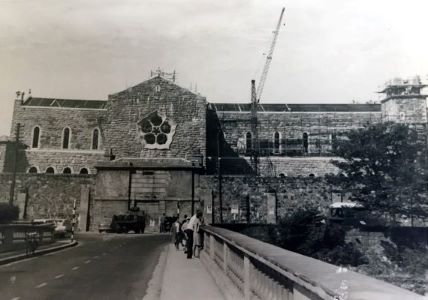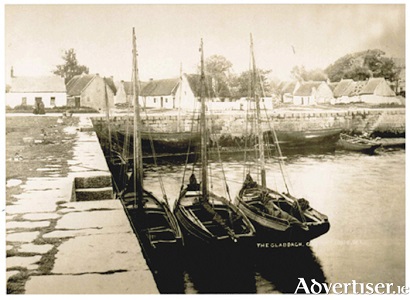Old Galway
Galway Cathedral

by Tom Kenny
In 1939, the Government decided there was no longer need for a jail in Galway. Galway County Council then decided to transfer the site of the jail to the Bishop of Galway for a nominal sum as a site for the erection of a cathedral.
AN ACCOUNT BOOK OF THE DOMINICANS IN THE CLADDAGH 1727-1738

by Tom Kenny
In 1698, the Dominican Community in the Claddagh were dispersed and exiled under a general exile of religious orders but within a few years, three of the friars had returned. It was the time of the Penal Laws, but gradually the pressure on these fathers eased, thanks largely to the refusal of the Mayor and Sheriffs to implement the anti-Catholic mandate of the English government. The priests were back in the Claddagh, tolerated by the officials.
Claddagh fishermen

by Tom Kenny
When the Claddagh fishermen worked, they did it with a will, and when not fishing, they were generally found mending their nets. They had the reputation of being so well prepared for sea, that lives were seldom lost when they went fishing. The strand often presented a lively sight at The Claddagh preparatory to the men proceeding to sea. They usually brought with them some oatmeal cakes, potatoes, water, and firing, no spirits of any kind.
WILLIAMSGATE STREET, 1903

by Tom Kenny
The recent Royal Visit of William and Kate prompted us to dig out this photograph of Williamsgate Street taken in August 1903. It was taken just before or after King Edward VII and Queen Alexandra passed through. There were more banners and flags up while they were in the vicinity. The Royals had sailed into Killery Harbour on the royal yacht, then toured Conamara and then travelled by train to Galway. Their visit here was full of pomp and ceremony.
MONTPELIER TERRACE IN THE 1950’S

by Tom Kenny
According to An Foras Forbartha’s book on Galway Architectural Heritage, “Montpelier Terrace curves around the corner to the Crescent. The first two houses are of 3 bays and two storeys over basements with rendered walls and railings in front. They date from c.1840. Next are two houses without basements of two bays and three storeys with elliptical headed door-cases fronted by simple railings.
Celebrating Eilís Dillon

by Tom Kenny
Eilís Dillon was born on March 7, 1920, in Galway. Her parents were Professor Tom Dillon and Geraldine Plunkett, who was a sister of Joseph Mary Plunkett. They were very republican and were forced to move a number of times. They lived for a time in Daingean House and later in Barna for a few years. Eilís went to Barna National School where she became fluent at Irish, later to the Presentation, and later still to the Ursuline Convent in Sligo. She worked for a while in the hotel business.
THE WHITE BRIDGE

by Tom Kenny
This photograph of the Galway-Clifden Railway Bridge over the river was taken from the west side, looking towards Bohermore. It was built in 1894 and consisted of three spans of 150 feet with a 21 foot span in the centre. This centre one was a lifting one on the bascule principle to allow for navigation of boats and steamers from the sea and canal to the lake.
SIXTH CLASS, THE MERCY, 1948

by Tom Kenny
One hundred and eighty years ago, the Sisters of Mercy came to Galway for the first time, to a house in Lombard Street, to devote themselves to works of mercy among the poor. The great Catherine McAuley was one of the first three nuns to come here, the others being Mother M. Teresa White and Mother N. Catherine Leahy.
.png)